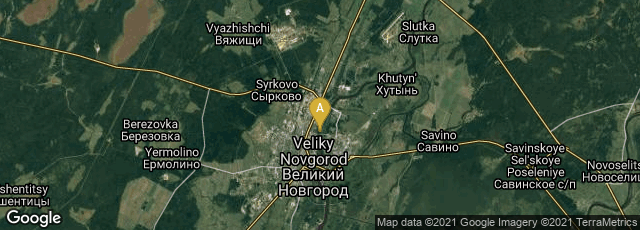

A: Veliky Novgorod, Novgorodskaya oblast', Russia
On July 13, 2000 the Novgorod Codex (Новгородский кодекс) was discovered in Novgorod (Veliky Novgorod), Russia. More early Russian manuscripts survived in Novgorod than any other Russian city, probably because Novgorod was not occupied by the Mongols. The earliest surviving book of the Rus' people, the Novgorod Codex is a palimpsest consisting of three bound wooden tablets containing four pages filled with wax, on which its former owner wrote down dozens, probably hundreds of texts during two or three decades, each time wiping out the preceding text. The tablets measure 19 x 15 x 1 cm, and have a 15 x 11.5 cm indentation filled with wax. The two exterior tablets have one wax layer and one blank wooden side, and the third interior tablet has two wax sides. The boards have round holes at one edge, through which wooden pegs were inserted, holding the tablets together as a four-page book.
"The tablets were discovered in a stratum 50 cm away and 30 cm below a wooden walkway dendrochronologically dated to the year 1036. As the strata in Novgorod are estimated to have grown at about 1 cm per year, the document was estimated to have been placed there around 1015-1020. Subsequent radiocarbon dating of the wax at the Uppsala University in Sweden gave the range of 760 AD to 1030 AD with a 95.4% certainty. Due to the Christian text on the tablets, dates earlier than the Christianization of Kievan Rus' in 988 are considered unlikely, and as such, the wax tablets are reliably dated to a very narrow 42-year window between 988 and 1030 AD."
"The wax of the codex itself contains psalms 75 and 76 (and a small fragment of psalm 67). This is the so-called basic text of the Novgorod Codex. Consequently, the book is alternatively known as the Novgorod Psalter. This text can be read as easily as any other document on parchment and could be examined at once. The Psalter translation exhibits a somewhat different translatory tradition than the Slavonic translations of the Psalter known so far (especially the Psalterium Sinaiticum)."
"Preservation of the tablets presented unique challenges, as the usual preservation method for wood would have destroyed the wax layer, and vice versa. The method eventually decided on called for careful separation of the wax layer, and preserving each material separately. The newly exposed wood under the removed wax was found to have been extensively scratched by the stylus cutting through the thin wax. It took the research team several weeks to realize that some symbols could be discerned in the scratches.
"Famed Russian linguist Andrey Zaliznyak, one of the foremost experts on the early medieval Novgorod dialect, has taken tremendous effort to reconstruct so far only a small portion of the texts preceding the basic text. The main difficulty with this task is the fact that the feeble traces of dozens of thousands of letters left by the stylus, often hardly discernible from the natural shading of the soft lime wood, have been superimposed on each other, producing an impenetrable labyrinth of lines (Zaliznyak speaks of a “hyper-palimpsest”). Consequently, ‘reading’ a single concealed text of one page can take weeks" (all quotations from Wikipedia article on Novgorod Codex, accessed 01-19-2013).